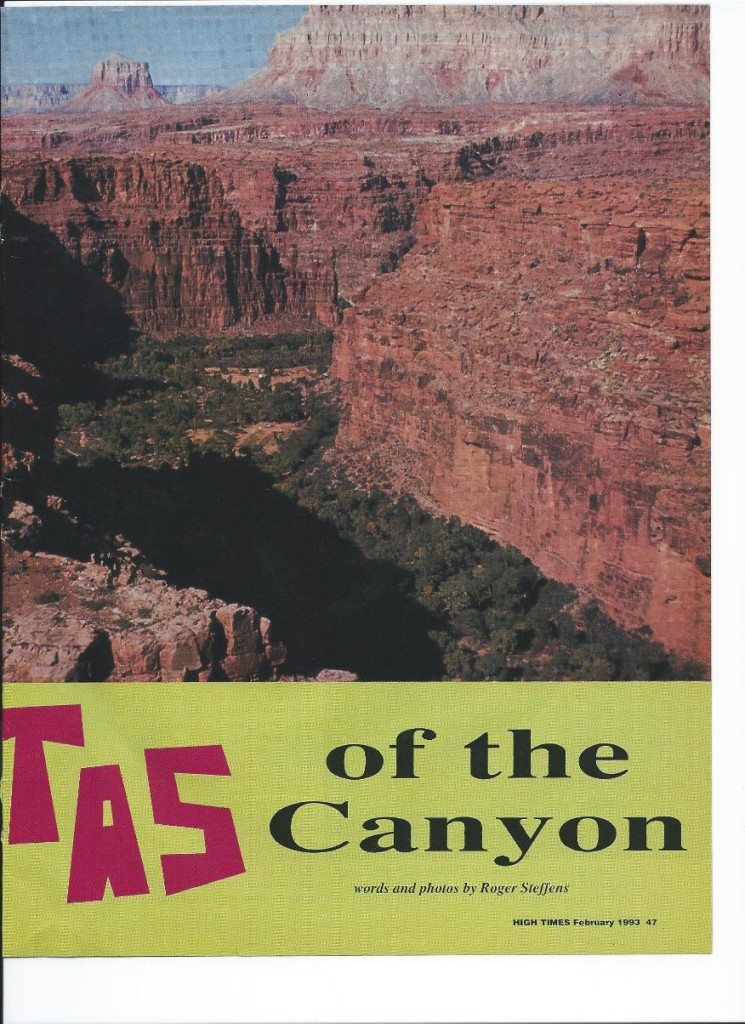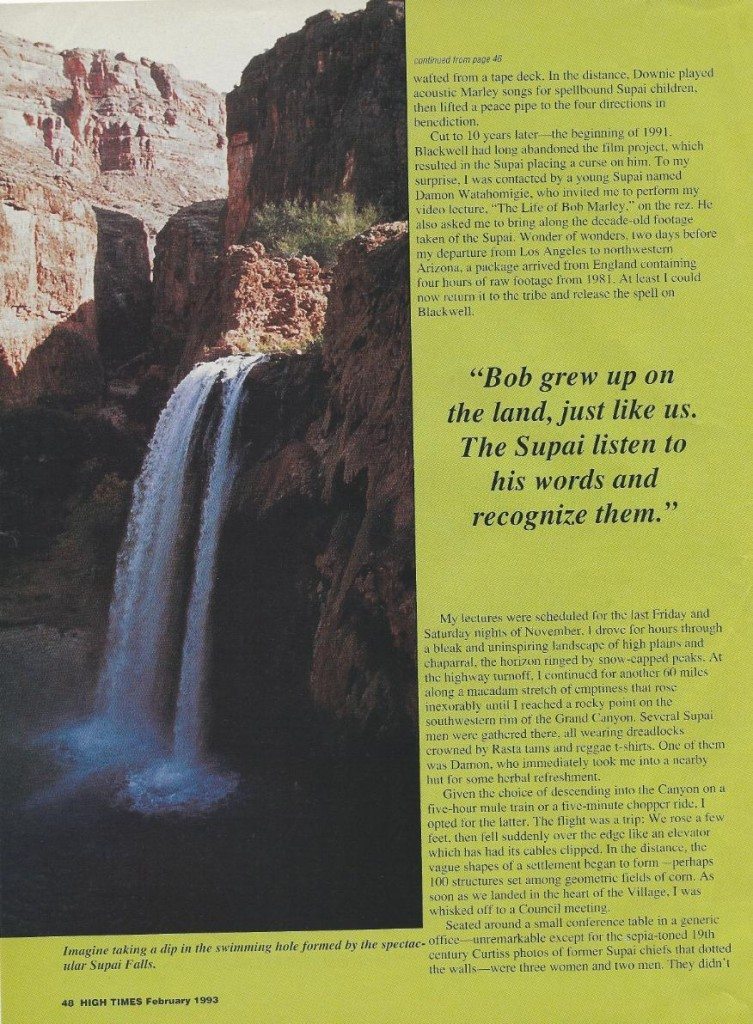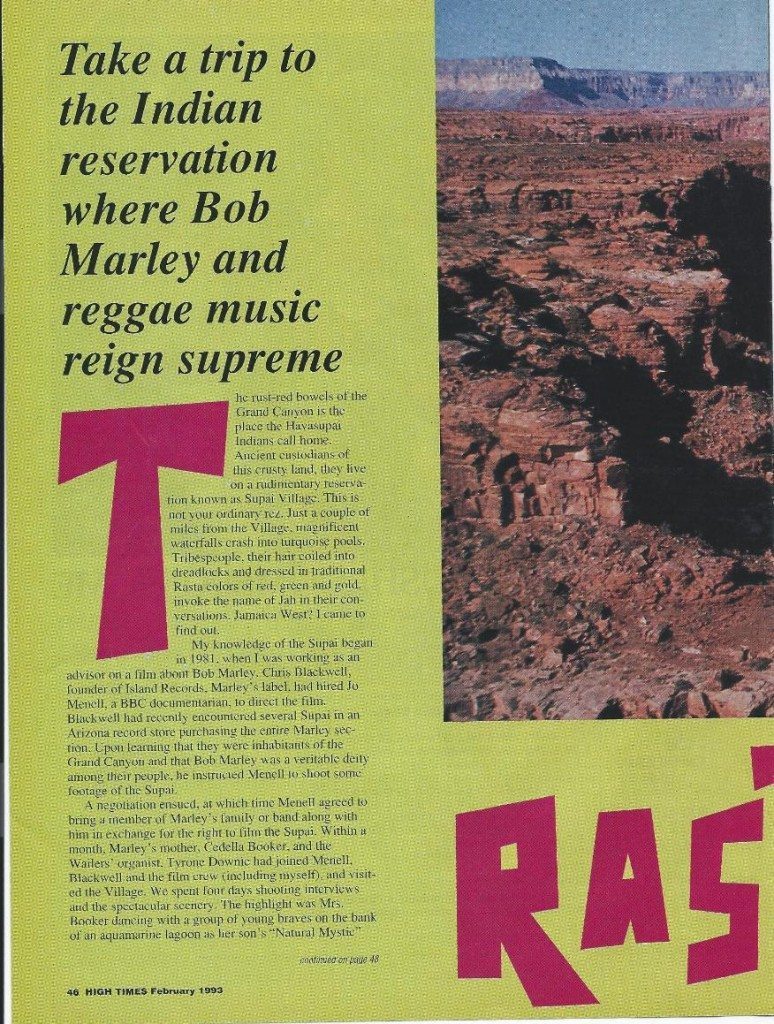Bob Marley Prophecy & Connection to Havasupai Native Americans
Supai have prophecies that show that the great resistance fighter Crazy Horse would return in the form of a black man. Many believe Bob Marley to be the fulfillment of that prophesy. Bob Marley’s music and messages are important parts of the daily lives of the Supai. Their struggle against oppression and their connection to the land and great spirit make a strong connection to Bob Marley and Rastafari. A great example of the love they have for Bob Marley and his songs is this story from the book “Understanding The Connections between Black and Aboriginal Peoples.”
From Robert Roskind, author of “Rasta Heart: A Journey into One Love.”Our visits there had unraveled the mystery of why yet another ancient and isolated tribe were Bob Marley and reggae fans. We had met with Supai Waters, one the tribal members who in the 1970s brought Bob’s music there to uplift the vibes in the village. Soon afterwards, tribal members got battery-operated tape decks (there was no electricity in the village then) and started listening to his music.
From Robert Roskind, author of “Rasta Heart: A Journey into One Love”: Bob had planned to visit the tribe but died before he could make it there. A year later, in 1982, Bob’s mother, Mama B, honored her son’s wishes by visiting the village, along with Tyrone Downey, a member of Bob’s band. In front of Havasu Falls, their sacred waterfall, many of the tribe gathered as Mama B sang Bob’s songs. Many remember her visit as the high moment in recent tribal history.
Bob Marley has been a very inspirational figure to the Havasuapi, to the young people to the little people to the older people. I walked into a room once where there was an eighty year old listening to Bob Marley singing and she was in tears. The music was Redemption Song. I said, “What’s the matter?” and she said, “I like the words here. It reminds me of the prayers of the old people -the way they used to pray. It reaches down into the soul -the spiritual soul -way down in there.” I said to her “I’m glad you are crying because I feel the same way every time I hear it.”
They are one of the oldest Indian Nations in North America and then consider that their only connection to anything truly foreign to their culture is reggae music, they get their mail by mule, and what they don’t grow themselves has to be flown in by the government. Then consider that they believe that the most popular reggae-recording artist in history, Bob Marley, is the reincarnation of a great Native American rebel leader who fought against the oppression of the white man and the thievery of lands by our forefathers. This shows without a doubt the potency of Bob Marley’s campaign for peace, love and the spread of Rastafari.
Bob Marley was one of the most successful at spreading the faith; his popularity afforded him the opportunity to travel the globe chanting the word of Jah.
The Havasupai are a Native American tribe that is located in Arizona, particularly the base of the Grand Canyon. In 1882 The Havasupai Indian Reservation was formed. This reservation consisted of around 500 acres within the Grand Canyon. This essentially trapped the Havasupai within the canyon for almost 100 years. Supai is so isolated that government helicopters deliver much of the food supply. That being said, the essentially isolated capitol city of the Havasupai Reservation, Supai is home to some of the most prudent reggae fans in the entire world. They understand how it feels to be made to move around by oppressive forces. Obesity and diabetes are becoming more and more of a health concern in the community due to the amount of junk food being delivered by government helicopters (White).
This imported food has replaced in a big part the Havasupai grown food. The same has happened in Jamaica. The growing global economy has made it possible to import cheaper goods from far off places; these goods are replacing goods grown by smalltime farmers etc, etc. Corporations like Chaquita Banana, can afford to undercut prices so dramatically that they are bullying these farmers out of their own market (Life and Debt). The Havasupai also relate to the Rastafarian colors: red, gold and green,“… for them red stood for the people; the earth and the red canyon walls; green represented the trees; and gold the sun.” The Havasupai are also currently fighting a campaign against Uranium mining on their lands. In 1990 a federal court judge ruled against the Havasupai tribe, allowing the company Energy Fuels Nuclear to continue a project on sacred land Havasupai land.
“We were promised that we would be able to continue to practice our religion on our ancient land. If our religion is destroyed, how can we practice? … We were promised access to our sacred sites. Right now EFN has a fence around one of them and we can only get in with permission from the mining company.” (Byrne 111.)
The Havasupai plight is similar to that of many indigenous cultures around the world. Jamaicans know a good deal about broken promises themselves. Jamaica has always been a means of generating wealth for whites. Jamaicans were constantly promised freedom, at the expense of betraying their brothers and sisters. Even when Jamaica eventually gained its freedom, it was still under the rule of white men and its people were still bound in the shackles of poverty and illiteracy. This is why I believe that reggae translates so openly to other indigenous cultures. Maybe when these Havasupai hear Bob sing in Redemption Song, “have no fear for atomic energy” they hear his voice chant directly to them. It’s a personal and spiritual understanding that they share. Bob isn’t considered to be just any ordinary musician by the Havasupai. The Havasupai actually believe that Bob was the reincarnation of the legendary resistance fighter Chief Crazy Horse. It was prophesised that Crazy Horse would be reincarnated as a black man and that Bob was the fulfillment of said prophecy.
Here is a great article by reggae historian Roger Steffens who took a trip to Havasupai in 1991 to meet the people in person. Article taken from High Times Feb. 1993.




Additional Source: Bob Marley Concerts







